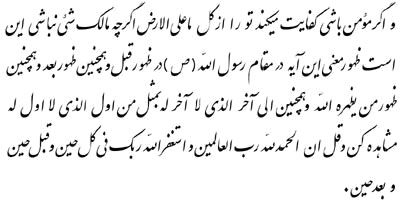Baha’s Date of Annunciation
Explanation of Some Terms
After a While (Ba’d Hin بعد حین)
1. Baha’s Date of Annunciation
1.1 Explanation of Some Terms
1.1.6 After a While (Ba’d Hin بعد حین)
The year of ‘a while’ (sana-i-Hin) is 68 (ح=8, ی=10,ن = 50), and the year ‘after a while’ therefore corresponds to 69, which is the number after 68.”.
In his Persian Dalail-i-Sabai (The Seven Proofs), the Primal Point quotes, among other things as a proof of his manifestation, Sheikh Ahmad of Ihsa, the founder of the Sheikhi school, see Background to the Bayanic faith, as saying to his disciples with reference to the signs of the manifestation, “you will know the news of it after a while”.
Point’s Seven Proof
The Seven Proof: P.59, after alluding to the statement attributed to Shaykh Ahmad of Ahsa to the effect that “foreshadowing of the Manifestation are innumerable”, the Primal Point quotes the Shaykh as having written in his own handwriting to Sayyid Kazim of Rasht saying: “Certainly to this Cause is its resting-place [i.e. appointed time], and every message is its abiding place [i.e. set time], and no reply may be given fixing [the time], and after a while (Ba’ad Hin) shall ye surely know its message.”
This is the passage in which the words “after a while” appear. There is no “year” preceding the words “after a while”, as alleged.
This is the word “Hin”, to which Baha’s “divine mission” is pinned.

Shoghi Effendi’s Version
As regards the term ‘after Hin’ (Ba’d Hin, which means ‘after a while’, ‘after a time’, erelong), to which Baha’s pretensions are pinned, Shoghi Effendi interprets it as ‘the year 1268 A.H. (1852), in which Baha” is stated to have “received the first intimations of his divine mission,” following the attempt on the Shah’s life in August 1852, and more than two years after the execution of the BÂB in July 1850. This means that the BÂB, alleged “co-founder” of Bahaism, passed away unaware of his co-founder Baha’s mission.
Dr. Browne’s footnote 2 in his translation of the Travellers's Narrative P. 55:
In J.R.A.S. April 1892, P. 304, Dr. Browne says: “… In the Traveller’s Narrative (P. 63) we are told that it [i.e. Baha’s Manifestation] did take place in the month of Muharram in the year A.H. 1269 (October 15-November 13, 1852), which statement appears impossible, inasmuch as Baha was arrested in August 1852, and imprisoned for four months at Teheran ere he was suffered to depart to Baghdad.”
Strange enough Shoghi Effendi makes no mention of Baha’s “manifestation” on arrival at Baghdad from Tehran, as alleged by Sir Abbas Effendi (see infra).
Abbas Effendi’s Version
Contradicting Shoghi Effendi, Sir Abbas Effendi interprets it as “Muharram 1, 1269 A.H. (October 15, 1852), “when Baha revealed himself” on setting foot in Baghdad upon expulsion from Iran. This date is cooked, as Baha was a state guest in prison in Teheran on that date. In his god passes by, P. 109, Shoghi Effendi states that Baha arrived in Baghdad, upon expulsion from Iran, on Jamad Thani 28, 1269 A.H. (April 8, 1853).”
Belying Sir Abbas Effendi who says that Baha ‘revealed himself’ on arrival in Baghdad from Teheran, Shoghi Effendi, in god passes by, PP. 151-155, states that Baha “revealed himself” in the garden of Ridvan in Baghdad on the eve of his departure from there to Istanbul on “Dhil Qa’da 14, 1279 A.H. (May 3, 1863).”
These are specimens of Bahai hierarchy’s misrepresentations of historical facts to fit Baha into the Bayanic dispensation.
To read more about Bahaism, go to the main page, select 'Bahaism' and navigate through the index.